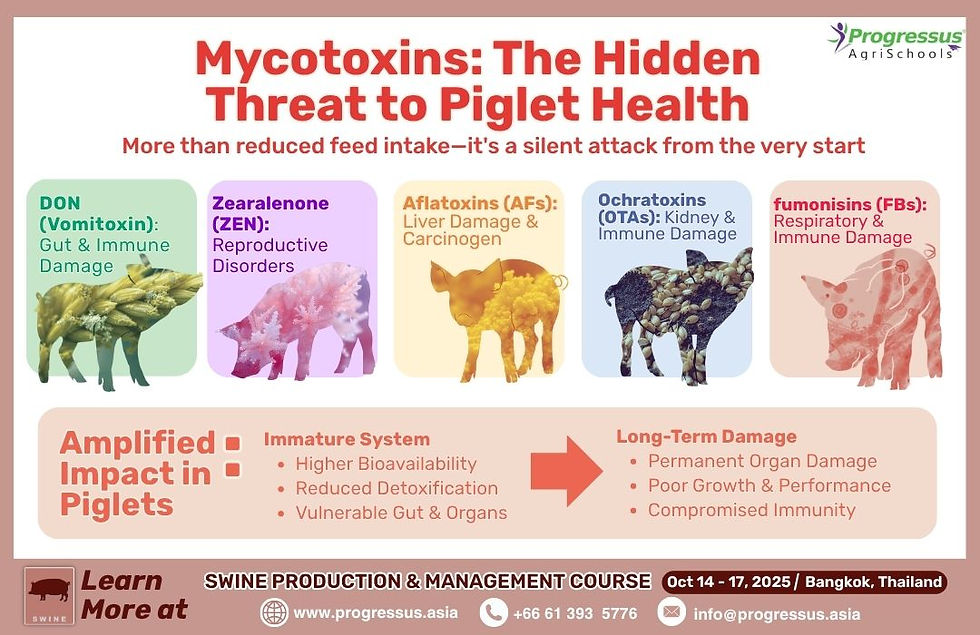Is Your Herd at Risk? The Mycotoxin Threat to Piglet Health
- Progressus

- Aug 4
- 4 min read
The vulnerability of piglets to mycotoxins often flies under the radar, deceptively shielded by their relatively modest feed intake. However, as we've established, the transplacental passage from sow to piglet, coupled with the transfer via colostrum and milk, presents a significant pathway for early exposure with potentially devastating health repercussions.
While Deoxynivalenol (DON), or vomitoxin, serves as a prime example of a prevalent threat from Fusarium fungi in cereals, the danger extends across a broader spectrum of mycotoxins, each wielding unique toxicological effects that disproportionately impact these young, developing animals.

Consider, for instance, aflatoxins (AFs), the insidious byproducts of Aspergillus mold. Their potent hepatotoxic and carcinogenic properties pose a silent but serious threat. Even minute quantities ingested by the sow can be transferred through her milk, burdening the piglet's still-developing liver, hindering growth, and crippling its nascent immune system. This early aflatoxin exposure can set the stage for long-term health vulnerabilities and reduced productivity.
Another significant player in the mycotoxin landscape is zearalenone (ZEN), also a product of Fusarium fungi. Its estrogenic activity can disrupt the delicate hormonal balance in piglets. Even before they reach sexual maturity, exposure to ZEN can lead to reproductive abnormalities, such as vulvovaginitis in pre-pubertal gilts, potentially compromising their future reproductive capacity and the overall efficiency of the swine herd.
The fumonisins (FBs), stemming from Fusarium moniliforme and F. proliferatum, add another layer of complexity. While notorious for causing porcine pulmonary edema (PPE) in older swine, their chronic, low-level exposure in piglets can manifest in more subtle yet equally damaging ways, including insidious reductions in weight gain, subclinical liver damage, and a weakening of the immune defenses, leaving them more susceptible to opportunistic infections.
Furthermore, ochratoxins (OTAs), produced by Aspergillus and Penicillium species, target the kidneys and the immune system. Piglets exposed to OTAs, whether through contaminated feed consumed by the sow or directly through contaminated creep feed, can suffer kidney damage, impairing their ability to effectively filter waste and further hindering their growth and overall health. The immunosuppressive nature of OTAs also compounds the risk of disease outbreaks within a piglet population.
The heightened susceptibility of young piglets to mycotoxins is a critical factor. Their still-maturing metabolic machinery, particularly within the liver and gastrointestinal tract, is simply not as adept at detoxifying these harmful compounds compared to their older counterparts. This immaturity leads to a higher bioavailability of the toxins, meaning a greater percentage is absorbed into their bloodstream and circulates throughout their vulnerable systems for longer periods.
This prolonged exposure amplifies the toxic effects on their rapidly dividing cells, including the delicate lining of their gut, the crucial components of their immune system, and the tissues of their developing organs.
The consequences of early mycotoxin exposure extend far beyond immediate, acute symptoms. Chronic, low-level exposure can inflict irreversible damage on vital organs like the liver and kidneys, casting a long shadow over the pig's potential for healthy and productive growth. The insidious erosion of their immune system makes piglets more vulnerable to a host of common swine diseases, necessitating increased reliance on antibiotics and potentially leading to higher mortality rates.
Moreover, the subtle but persistent growth retardation and the uneven development within litters can significantly impact the economic viability of a swine operation. Alarmingly, a compromised immune system can even hinder the efficacy of vital vaccination programs, leaving piglets inadequately protected against prevalent pathogens.
In conclusion, the threat posed by mycotoxins to piglets is multifaceted and far-reaching, extending well beyond the simplistic notion of feed intake. The diversity of mycotoxins, their varied toxicological mechanisms, and the heightened vulnerability of young animals due to immature metabolism and developing organ systems create a significant and often underestimated challenge to piglet health and swine production.
Recognizing the insidious nature of these toxins and implementing proactive, comprehensive strategies for feed quality control, from sourcing raw materials to storage and potential detoxification measures, is paramount to safeguarding the health, welfare, and economic potential of our swine herds. Only through a diligent and informed approach can we effectively mitigate this everyday risk to the immune quality and overall well-being of piglets.
Some aspects of mycotoxin toxicity in piglets, particularly regarding zearalenone’s variable impact on growth and the complex synergistic interactions among multiple toxins, remain topics of ongoing research and discussion. While the estrogenic effects of ZEN on reproductive development are well established, its influence on growth performance is not uniformly reported across studies, leading to regional differences in regulatory limits that reflect this uncertainty. Moreover, co-contamination by multiple mycotoxins can produce additive or synergistic effects on piglet health, but the specific toxicological outcomes depend on the particular combination and levels of toxins.
Additionally, differences in the transfer efficiency of mycotoxins like ochratoxins through colostrum and milk between species mean that extrapolations from pig studies or other animals must be made cautiously. The bidirectional modulation of the immune system—both suppression and overstimulation—by mycotoxins further complicates therapeutic and preventive interventions, such as vaccination efficacy. These nuances highlight the importance of comprehensive feed analysis, tailored mycotoxin management strategies, and continued research to fully elucidate exposure risks in piglets.




Comments